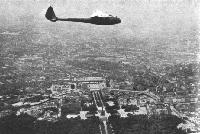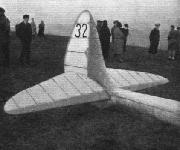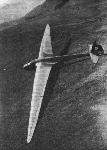
M.Simons The World's Vintage Sailplanes 1908-45
THE FAFNIR
The Fafnir was designed by Alexander Lippisch and built by the RRG workshops on the Wasserkuppe, for the 1930 Rhoen competitions. It was made to fit the body contours of Guenther Groenhoff. a small, but as it proved, very skilful pilot. All the main principles affecting the performance of a sailplane were known to Lippisch by now. Struts like those on the Wien, were eliminated. The aspect ratio remained almost as high. To avoid excessive weight the root of the cantilever structure had to be made very deep. The Fafnir wing was strongly tapered. At the root, the thick, very greatly cambered aerofoil. Goettingen 652, was used, this changed progressively to Goettingen 535 at the mid-span station and thence to Clark Y at the tip. This change of profile plus several degrees of negative twist or ‘washout', prevented tip stalling at low airspeeds, and improved aileron control.
The wing was slightly cranked to give the attractive ‘gull’ form. Lippisch's liking for this shape went back to the tailless Weltensegler of 1921. The reasons usually given for it were that it raised the wingtips clear of the ground during landings and take offs, and it was also thought to improve stability in turns. Both could have been achieved by giving the wing a slight, straight dihedral angle. Still, the Fafnir was acclaimed as the most beautiful sailplane ever built and set a fashion which persisted until the 1950s.
The wing had three spars, a main, box beam at the one-third chord position, with two auxiliary ‘I’ beams fore and aft. The leading edge was plywood covered, as was usual by now. The ribs were more closely spaced than on other gliders, to preserve an accurate profile. Lippisch gave a great deal of attention to the junction of the wing and fuselage. The centre section was built integrally with the fuselage and a very elaborate, three-dimensionally curved fairing was built up out of numerous small strips of plywood. In service, several modifications were tried to improve the airflow near the leading edge. To reduce drag from the open cockpit, a wooden canopy was constructed and was faired into the nose and wing roots, with portholes on either side. There was no landing wheel, the skid being cleverly sprung by means of a row of tennis balls trapped between the keel and the ash skid by wooden laths and a canvas or leather covering. Ground clearance all the way along the fuselage belly, and especially at the tail, was very small and this gave much trouble in service.
After the 1930 contest, Groenhoff in 1931, as a member of a team experimenting with aero-tow launching, became the first glider pilot ever to exceed 200 km distance in soaring flight. His 278 km from Munich on 4th May 1931 was not officially allowed as a record because aero-towing had not been recognised by the FAI for such purposes. During this flight, in stormy conditions, the wing was badly holed by hail and accumulated quantities of ice and water which sloshed around inside. When, on 24th July, Groenhoff achieved 220 km from a bungey launch at the Wasserkuppe, this was accepted. On this occasion he flew on until after darkness and in the end landed using his electric torch, poked out of the barely adequate portholes, to make his landing.
Later the Fafnir went to the High Alps. Launches were made by bungee from deep snow on the slopes of the Jungfraujoch. Ten men on each side of the launching rope were used, but even so, in the rarified air and hampered by the snow, the Fafnir on its first attempt did not reach flying speed. Groenhoff then found himself sliding down the slope toward a precipice. To the horror of the launching crew the sailplane toppled over the edge, and as it did so the tail hit a snow wall, tearing off half the elevator. The damaged Fafnir dropped into space. After falling vertically for about 100 metres without hitting anything, sufficient airspeed was attained for the controls to respond and Groenhoff was able to pull out of the dive away from the rocks, out over the open valley. The pilot realised that he had lost half his elevator and decided to maintain a high airspeed until he could reach the centre of the valley where there would be enough height for him to use his parachute. The sailplane behaved normally provided the airspeed was maintained. Hating to lose his beloved Fafnir. Groenhoff decided after all to try to save it. Choosing a large flat meadow near the edge of the town he made a very fast touchdown. A wingtip caught in the long grass and a severe ground loop resulted. The Fafnir slid for twenty metres sideways, and came to rest without further damage.
Two days later, with a new tailplane sent from the Wasserkuppe. Groenhoff again flew the Fafnir from the Jungfraujoch, this time gliding down to a landing, which by comparison with his previous escapade, was something of an anticlimax. Several days of poor soaring weather followed. On his first flight after this. Groenhoff found he had no rudder control, but was able to get safely down into the valley, where it was found that during the launch the wooden block at the rear end of the fuselage (where the hold-back hook for bungee launching was mounted) had broken off. This had taken with it the main rudder mounting and brought the rudder itself out of its bearings. Only four flights were made by the Fafnir from this lofty launching point. Two of them had been nearly disastrous. The fourth, when Groenhoff soared away to land at Bern aerodrome, was successful.
Groenhoff became the third pilot in the world to gain the coveted Silver ‘C’ badge, after Kronfeld and Hirth.
At the 1932 Rhoen came disaster. Groenhoff. hurrying back to the launching point for what would now be termed a ‘relight’, found that the wind had changed. Instead of moving to another launching point he allowed himself to be bungeed off downwind. The Fafnir skidded down the slope and finally got into the air, its tail dragging on the ground. At this moment the elevator struck a rock, the aluminium tube on which it pivoted was bent and the elevator control jammed. Groenhoff, this time, decided to bail out and did so, but his parachute did not open until he hit the trees and he was killed. The Fafnir fell into the forest. One wing broke off close to the root and the fuselage was badly damaged.
Georgii and Lippisch, director and head respectively of the technical division of the RRG, decided to repair the remains of the Fafnir. This time the cockpit was built large enough to accommodate pilots of average size and the old wooden canopy was replaced by a transparent one. In this form Peter Riedel flew it 228 km from Darmstadt into France in June 1933. Riedel, later in the same year, won the Rhoen contest and was awarded the Hindenburg Cup.
In 1934 with the Fafnir, Riedel accompanied Georgii’s expedition to Brazil and Argentina. The Fafnir achieved good cross-country soaring flights, the first accomplished in Latin America, and on one occasion Riedel soared for seven hours over Buenos Aires. On return, the Fafnir remained in use for some years at Darmstadt, where the DFS, successor to the RRG, established its headquarters. By 1938 the Fafnir was retired. It was destroyed in a Berlin museum during the Second World War.
Technical data:
Fafnir: Span, 19.00 m. Wing area, 18.6 sqm. Empty weight. 220 kg. Flying weight. 315 kg. Wing loading, 16.9 kg/sq m. Aerofoils, root, Goettingen 652, mid-span. Goettingen 535 and tip, Clark Y.
- M.Simons The World's Vintage Sailplanes 1908-45
Фотографии
-
Aeroplane Monthly 1985-06 / B.Johnson - Flugkapitan Hanna Reitsch. 1914-1979 (1)
The beautiful Lippisch-designed Fafnir sailplane competing at the 1930 Wasserkuppe meeting held in the German Rhon hills. The Rhon was the hub of the German gliding movement during the Thirties.
-
Flight 1930-08 / Flight
The Fafnir in the air, flown by Herr Groenhoff just after taking off at the Wasserkuppe
-
Flight 1930-08 / Flight
The "Fafnir," an interesting new glider built by the Rhon-Rossitten Gesellschaft, in flight at the Wasserkuppe during the competitions now in progress. The bird-like wings and the extraordinarily high aspect ratio should be noted. Extreme care has been taken in fairing the fuselage, and the pilot sits in a modified form of cabin, a centre fairing going right over his head and merging into the centre of the wing.
-
GL / M.Simons - The World's Vintage Sailplanes 1908-45 /Kookaburra/
One of the most famous sailplane photographs ever taken, showing Groenhoff in the Fafnir carrying out a low turn over the gentler slopes of the Wasserkuppe. Soaring over slight declivities in the ground, even along the edges of forests where the trees deflected the wind upward, was quite common among the expert pilots. The large venturi on the lower fuselage side in the picture was used to drive gyroscopic blind flying instruments.
-
Flight 1933-11 / Flight
GLIDER EXPERIMENTS OVER BERLIN: Peter Riedel in the "Fafnir" sailplane soaring over Berlin.
-
GL / M.Simons - The World's Vintage Sailplanes 1908-45 /Kookaburra/
Another photograph showing the nose of the Fafnir. It is expected that it will have a very flat gliding angle. The care with which all corners have been faired in can be seen.
Groenhoff in the Fafnir cockpit. Behind the starboard wing, in the dark suit and with arms akimbo, stands Peter Riedel. -
GL / M.Simons - The World's Vintage Sailplanes 1908-45 /Kookaburra/
Groenhoff in the Fafnir cockpit after the modification to the wing root fairing in 1931. The revised form of wing root was a great improvement. Outlook to either side through the portholes was adequate, this being especially important in turns, the chances of collision with another sailplane being considered remote. To see straight ahead during landing required only a small sideways head movement.
-
GL / M.Simons - The World's Vintage Sailplanes 1908-45 /Kookaburra/
Groenhoff with the Fafnir in 1931. By this time the wing root junction had been altered to improve the airflow.
-
Flight 1930-08 / Flight
The tail units of the Fafnir, which has been designed by Herr Lippisch to replace the Wien.
-
Flight 1934-08 / Flight
A RECORD BREAKER: The sailplane Fafnir II with which Heini Dittmar flew a record distance of 235 miles between the Wasserkuppe and Liban (Czechoslovakia) during the Rhoen gliding contest
-
GL / M.Simons - The World's Vintage Sailplanes 1908-45 /Kookaburra/
Peter Riedel flying his winning Fafnir at the Rhoen contest in 1934. The revised cockpit canopy is just detectable. The clear varnish finish was retained and the swastika, in a white disc on a red band, had been added to the rudder only. The letter D for Deutschland, and the name Fafnir, had been painted on the fuselage sides aft of the wing.
- Фотографии











